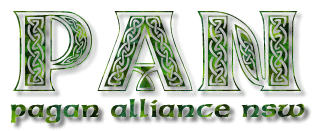|
Yule 1999 Newsletter Yule |

|
Yule, or the Winter Solstice occurs each year between the 20th and 23rd June. The Winter Solstice marks on the calendar the longest night of the year, and consequently the shortest day. From the Solstice onwards the days will start to get longer, though they will still be cold, and will get colder still during the winter months. But it is comforting to remember that even though the days are cold, the days are getting longer and the warmth of spring will soon return to embrace us.
The Solstice is a celebration of light and the rebirth of the Sun. They days grow in length until the Summer Solstice in December. The young Sun is born on the Winter Solstice and takes over from the old Sun who has given its last energy to keep us warm before passing into the underworld.
A good, but cold, activity to do on Solstice morning is to get up to greet the birth of the new sun. You may like to make an offering to celebrate the Suns return and to encourage the earth to thaw out and feel the returning warmth. Prepare to welcome the Sun back when the first glimpse can be seen on your horizon. This is a powerful time to perform dawn magic that incorporates growth and increase.
Solstice time is a time to remember the promises of the new Sun and to share the warmth with others who are less fortunate. Perhaps you could organise a food or blanket drive for your local community support services.
In the Northern Hemisphere the Winter Solstice occurs around the Christmas holidays. Pagans there are surrounded by the traditional symbols of winter as a constant reminder of the season. Here we see those symbols in the middle of summer, and at Yule, we might feel a little ‘odd’ putting up a tree, and decorations. If this is the case, you might consider making a wreath to go on your door, or on a wall. It could be a wreath of evergreen foliage and symbols marking the start of the new solar year. Symbols for your tree or wreath might include pictures of the sun, baubles as a symbol of light, candles, fruit and many other symbols you can find in your garden as a reminder of the season. You can also have a great winter feast with family and friends, as a way of ‘surviving’ the winter season and celebrating Spring being on its way.
One of the most popular form of party drink was the ‘wassail cup’, deriving its name from the Anglo-Saxon term ‘waes hael’ (to be whole).
The Yule tree is traditionally an evergreen - a symbol of the survival of green life through the cold and barren winter months. It is a symbol that the declining winter Sun, will be replaced by the new Sun at Yule and that the Goddess/God of the earth would survive.
Along with the symbol of the evergreen Yule tree, ivy and mistletoe were important plants of the season, all symbolising fertility and everlasting life. Mistletoe was especially venerated by Celtic Druids, who, some say, are said to have ritually cut mistletoe in the sixth night of the moon.
The Yule log is another important symbol. This years log would have been traditionally kindled and lit with a small peice saved from last years log. The Yule log symbolises the light returning to conquer the darkness. Wishes for the coming year can be written on or attached to the log. Some people use a log with candles on it instead of burning a whole log. This might be appropriate for those who don’t have the space for a larger fire (eg in an urban environment).
Bells are rung to welcome back the sun, and to encourage it to wake up (a bit like an alarm clock!)
The most common colours associated with this time of year are red and green, but white and gold are also used. Stones associated with Yule include rubies and garnets.
Deities to honour at this time of the year include all newborn Gods and Goddesses, Sun Gods and Goddesses, all mother Goddesses and triple Goddesses.
Gods associated with Yule include:
Apollo (Greek)
Ra, Osiris and Horus (Egyptian)
Lugh (Celtic)
Odin (Norse)
Father Sun
Goddesses associated with Yule include:
The Morrigan, Brigit (Celtic)
Isis (Egyptian)
Demeter, Gaea, Pandora, Selene, Artemis (Greek)
Juno, Diana (Roman)
Astarte (Middle Eastern)
Spinning Woman (Native American)
Mother Earth
References
Midwinter’s night eve - Yule by Mike Nichols
PAN, Volume 3, Number 2, 1998
Yule and its Lore by Stornwing (JR Sutton)
Yule of our Ancestors by Wulfgar Greggarson
![]()